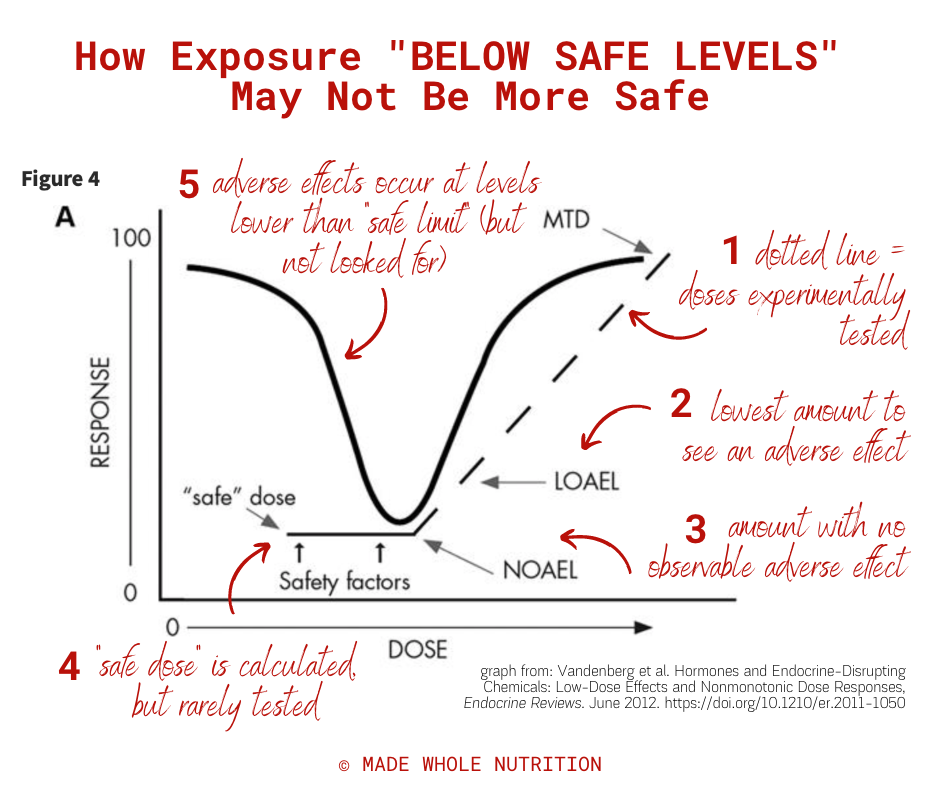How Toxicant Exposure "BELOW SAFE LEVELS" May Not Be More Safe
What if less is more with certain toxicants?
Conventional thinking (and decades of toxicological research) is based on the idea that:
higher levels = greater effects
lower levels = lesser effects
Therefore, “as long as exposure is below the point of no effect, we are in the clear”.
However, that thinking may cause us to miss half the graph.
It is a complete paradigm shift to consider that extremely low doses of a toxicant may be just as consequential as high doses, but that is what some scientists are proposing.
What is a non-monotonic dose response?
A non-monotonic dose response curve (NMDRC) is often U-shaped, with adverse effects seen at very high AND very low doses.
This means that the “safe level” or “reference range” for toxicant exposure may be safe, but levels below that may not be.
It is thought that hormones work in a similar dose-dependent manner, implicating that very low levels of endocrine-disrupting chemicals (EDCs) may be MORE dangerous than higher levels in the established “safe range”.
How is the safe range determined?
Let’s use the example of coffee and jitteriness to illustrate.
Several doses of a chemical, toxicant, or hormone are tested for their effects.
Test subjects are given 1/4 cup, 1/2 cup, or a full cup of coffee and assessed for feelings of jitteriness.
The lowest observable adverse effect level (LOAEL) is determined at the lowest dose of effect.
It is observed that those who drank a 1/2 cup or full cup of coffee are jittery. The LOAEL is 1/2 cup of coffee.
The no observable adverse effect level (NOAEL) is determined at the dose with no effect.
It is observed that those who drank a 1/4 cup did not get jittery, so the NOAEL is 1/4 cup of coffee.
The “safe” dose or range is determined to be any about of coffee below 1/4 cup.
This range is usually assumed and not tested again.
In the case of a NMDRC, there are also adverse effects at levels lower than the “safe limit”, but this range is rarely tested.
It would be as if a cup of water with a drop of coffee caused a similar level of jitteriness as a full cup of coffee (note that coffee does not seem to work this way, but many endocrine-disrupting toxicants do).
So what is to be done?
At this point, this is something toxicologists and regulators need to figure out when it comes to establishing “safe limits”.
As a consumer, your realm of influence extends to the choices you make about your food, products, and lifestyle.
While it would be ideal to completely avoid all toxicant exposure, this is simply not realistic.
Therefore, you can support your body’s natural detoxification processes by eating colorful plant foods, incorporating daily movement, and getting enough sleep.
Non-monotonic dose response curve (NMDRC) explained
References
Laura N. Vandenberg, Theo Colborn, Tyrone B. Hayes, Jerrold J. Heindel, David R. Jacobs, Jr., Duk-Hee Lee, Toshi Shioda, Ana M. Soto, Frederick S. vom Saal, Wade V. Welshons, R. Thomas Zoeller, John Peterson Myers, Hormones and Endocrine-Disrupting Chemicals: Low-Dose Effects and Nonmonotonic Dose Responses, Endocrine Reviews, Volume 33, Issue 3, 1 June 2012, Pages 378–455, https://doi.org/10.1210/er.2011-1050 Retrieved from: https://academic.oup.com/edrv/article/33/3/378/2354852
Lagarde, F., Beausoleil, C., Belcher, S.M. et al. Non-monotonic dose-response relationships and endocrine disruptors: a qualitative method of assessment. Environ Health 14, 13 (2015). https://doi.org/10.1186/1476-069X-14-13
Vandenberg L. N. (2013). Non-monotonic dose responses in studies of endocrine disrupting chemicals: bisphenol a as a case study. Dose-response : a publication of International Hormesis Society, 12(2), 259–276. https://doi.org/10.2203/dose-response.13-020.Vandenberg
Hill, C. E., Myers, J. P., & Vandenberg, L. N. (2018). Nonmonotonic Dose-Response Curves Occur in Dose Ranges That Are Relevant to Regulatory Decision-Making. Dose-response : a publication of International Hormesis Society, 16(3), 1559325818798282. https://doi.org/10.1177/1559325818798282
Bayer, J., Gläscher, J., Finsterbusch, J. et al. Linear and inverted U-shaped dose-response functions describe estrogen effects on hippocampal activity in young women. Nat Commun 9, 1220 (2018). https://doi.org/10.1038/s41467-018-03679-x



